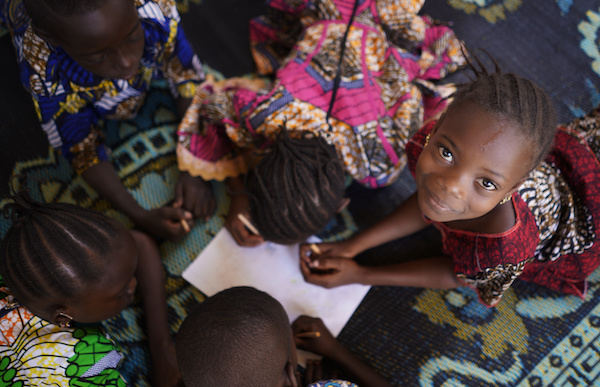Recommended

Blog Post

Blog Post
Launched in January 2023, the new US Strategy on Global Women’s Economic Security is the first of its kind to apply across federal agencies. Women’s economic security is a critical element of broader gender equality and a foundation for the well-being of households, communities, and countries. We are glad to see the Biden administration place an emphasis on this important issue. In particular, we welcome the strategy’s emphasis on care infrastructure and domestic work–and propose ways the US government can begin to implement its ambitious vision in the coming year.
It is not difficult to understand why care features prominently among the administration’s priorities. Improved access to quality care arrangements advances women’s economic empowerment, yielding positive economic and social impacts, whether in the United States or lower-income countries, reaching across populations grappling with economic instability or humanitarian crises. Investments in the care sector provide employment opportunities for paid care workers, while offering unpaid caregivers more flexibility to enter and advance within the labor market. The availability of childcare, for example, is associated with more women in the formal sector, as well as managerial and leadership roles, leading to reductions in the gender pay gap.
The Biden administration rightly takes an integrated approach to defining care, encompassing care for children, older people, and those living with illnesses and disabilities. Investing in all forms of care creates jobs and enables caregivers’ well-being. Quality childcare in particular affects future generations: evidence suggests childcare centers can improve nutrition, as well as facilitate access to developmental screenings and cognitive interventions. Studies demonstrate that quality early education can support language acquisition, pre-literacy skills, and enthusiasm for learning as well as socio-emotional skills linked to success in adulthood, including improved employment prospects and higher learning potential.
As the US Strategy on Global Women’s Economic Security marks a new milestone in the advancement of women’s economic standing, as well as children’s well-being, there is an opportunity to transition this ambitious strategy into concrete actions across diplomacy, development, trade, migration, and humanitarian assistance channels. How can this ambitious agenda be jumpstarted in 2023?
1. The US should exercise global leadership to catalyze global progress
With the launch of the strategy, as well as the G7 Partnership for Global Infrastructure and Investment (PGII), the United States has the opportunity to ensure other donor countries follow suit in recognizing care as a foreign policy priority. Through the 2023 G7, G20, and APEC Summits, as well as the Global Refugee Forum, the US can convene other global leaders to increase their attention to and investment in care as essential infrastructure. We recommend the US government:
- Encourage the rest of the G7–and other donor countries–to contribute to the World Bank’s Invest in Childcare Initiative. At present, the US, Canada, Germany, and Australia have contributed funds, but other donors should take advantage of this existing financing mechanism, which will increase access to quality childcare in the low-income countries;
- Use the United States’ leadership position at other international financial institutions (International Monetary Fund, regional development banks) to increase the emphasis these institutions place on care through lending and policy guidance;
- Track and publish the amount of official development assistance (ODA) allocated to care through bilateral aid and investment channels and work with OECD Development Assistance Committee (DAC) partners to develop a methodology for tracking these investments across donors. Currently, the DAC Creditor Reporting System lacks a code dedicated to care, so data limitations prevent a clear understanding of how investments have varied over time;
- Support civil society practitioners and advocates based in low- and middle-income countries, including fragile and conflicted-affected contexts, in line with the drive to localize development and humanitarian decision-making;
- Look beyond aid to open pathways for increased and improved migration for care workers. CGD and ODI research points to the need for increased global mobility to meet the employment needs of the care sector in the coming years. Germany and Canada offer models the US can emulate in considering migration pathways for care workers.
2. The strategy should incorporate more care-focused metrics for success
Though the strategy’s language surrounding care infrastructure and domestic work is ambitious, the metrics for success reflected in the strategy document are not comprehensive enough to measure progress across the full range of proposed actions. At present, the strategy includes just two indicators:
- Number of strategic diplomatic engagements to promote care infrastructure (State Department)
- Number of civil society and/or private sector consultations to promote care infrastructure (State Department)
Since “what gets measured gets done,” expanding the metrics of success to include those relevant to USAID, MCC, DFC, DOL, and other agencies will increase accountability for additional action. Through their implementation plans under the strategy, each agency should develop care-focused metrics. As one concrete example, the Development Finance Corporation could add a metric under its 2X Initiative focused on investing in care businesses and/or investing with firms who provide childcare to employees. Agencies can also consult the World Bank’s Invest in Childcare Theory of Change and Results Framework (forthcoming), which reflects clear metrics related to the provision of care services and benefits for women and children.
3. Agencies should aim for policy coherence and localized design
To promote alignment on this cross-sectoral issue, the White House and relevant agencies should create a community of practice to co-operationalize the US Strategy on Global Women’s Economic Security and the Global Child Thrive Act, bridging gaps across early childhood and gender equality constituencies to ensure cohesion.
Policy coherence should also be prioritized across humanitarian and development divides, recognizing that implementation will benefit from bespoke solutions for those facing crisis and conflict. Women living in refugee communities will face disproportionate challenges to legally work or receive education or access regular care infrastructure.
Finally, USAID and other agencies should also fund and empower local communities to drive solutions through mission-led engagement. The strategy’s success will require country specific and population specific planning, making the next step of demand creation critical. This requires a strong dissemination plan to missions across all the related strategies.
4. Agencies should harness the evidence on care infrastructure and child development
Though gaps in the evidence persist, a lot of high-quality research has been produced on the types of care arrangements that benefit those providing and receiving care, as well as the macroeconomic benefits of care investments. US agencies should rely on the existing evidence base – including evaluations conducted by CGD colleagues David Evans and Kehinde Ajayi – to inform their investments in care infrastructure.
As we did for the World Bank’s Early Learning Partnership, CGD will soon convene a small group of researchers and experts through a technical workshop aimed at USAID staff. The workshop will discuss context-specific data on (1) the returns childcare investments can yield; (2) design and implementation features that should be prioritized to ensure that childcare programs benefit children and parents or other caregivers; and (3) existing policy and financing landscape and how it can be further aligned with evidence on “what works.” This technical workshop will be followed by a series of learning events aimed at convening and informing the efforts of USAID mission staff–and this model could be applied to the evidence on other types of care investments, including those aimed at older populations or those living with disabilities and illnesses, as well as those supporting care workers themselves.
Research will also soon be released on IRC’s Ahlan Simsim and Play to Learn, the largest ECD programs in the history of humanitarian response, increasing knowledge on what works, with whom, and at what cost at the intersection of caregiver and child outcomes. As acutely experienced during COVID, care infrastructure is not always available and requires remote and digital interventions—which offer opportunities for both distributing the burden of care and improving women’s agency and wellbeing. Findings from three randomized controlled trials will offer insights on a Remote Early Learning Program, showing positive impact on both child development and caregiver-child engagement; “low dose” audio-only remote interventions, with positive findings on caregiver mental health; and a mass media evaluation studying the role multimedia can play in care programs as a tool for social emotional learning. The US government can learn from the proof of concept advanced by IRC, Sesame Workshop, BRAC, and NYU on how to appropriately support caregivers and advance child development outcomes.
In the next six months, US agencies will be tasked with developing concrete action plans to begin the strategy’s implementation. With the actions proposed above, the Biden administration can ensure several quick wins that catalyze longer-term progress.
Disclaimer
CGD blog posts reflect the views of the authors, drawing on prior research and experience in their areas of expertise. CGD is a nonpartisan, independent organization and does not take institutional positions.
Image credit for social media/web: Adobe Stock





